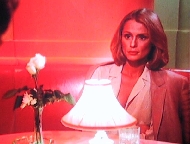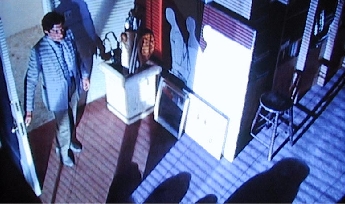American Gigolo (1980) writ. and dir. Paul Schrader cine. John Bailey music. Giorgio Moroder edt. Richard Halsey art. Ed Richardson (Ferdinando Scarfiotti, visual consultant) star. Richard Gere (Julian Kay), Lauren Hutton (Michelle Stratton), Hector Elizondo (Det. Sunday), Nina Van Pallandt (Anne), Bill Duke (Leon), Tom Stewart (Rheiman), Brian Davies (Sen. Stratton), Jessica Potter (Jill), Frances Bergen
Paramount
Fcourt
Lawrence Russell
flaccidity, orgasm and the bi-sexual landscape
The influence of classic film noir here is obvious in a) the cinematography and b) the sexual politics. While American Gigolo isn't as bad a film as many say, the heavy narcissism of the characters and the sets can be aggravating. It's difficult to have much sympathy for a hustler like Julian Kay (Richard Gere), a poseur who feeds off the sexual fantasies of affluent older women like some sort of moonlighting Calvin Klein model... or the woman who inexplicably loves him, Michelle Stratton (Lauren Hutton), the bored, unhappy Revlon wife of a Californian politician on the rise.



At the time of its release (1980), the film promised much in terms of sexual liberation and the evolving face of a feminist society. Yet there's something false here, and it isn't the homosexuals pretending to be heteros or the heteros pretending to be homosexuals. The landscape is bisexual -- and that's how it should be because that's the way it was, still is. Pre-AIDS, the world was now a commerce zone for sexual proclivity, and the ugly rhythm of the street sex culture was still concealed behind the glossy walls of fashion and advertising, the twin industries of attitude... and the heightened race against old age. In 1980, the only crime anyone cared about was flaccidity.
To say that Paul Schrader's artistic approach to his film is deliberate is an understatement but one that has to be noted. That the actors seem to be posing rather than acting much of the time is a deliberate gestalt of the period culture. The sense of the false is the message. It's the postmodernisms implicit in its landscape, the gutting of film noir decor and film noir psychology that make it the self-regarding exercise we sense that it is. Like the hero, it's a retrofit, a make-over of an old personality, and we're not entirely comfortable with the result.
Julian says he's originally from "Turino", which immediately casts him in the lineage of the Italian gigolo. He's the sort of manufactured fantasy that American women have long indulged in, like a visit to an Elysian spring, where men exist as beautiful statues easily animated for the satisfaction of their secret desires, compliant gods who are as easily manipulated as children. We've seen him before as the suffering petulant played by Montgomery Clift in de Sica's Indiscretion of an American Wife or the indefatigable Warren Beatty in The Roman Spring of Mrs. Stone. But Gere's Julian Kay is a much cooler, more savvy individual, a man who takes pride in his client's orgasm, even if it takes 3 hours to get there.
"Julie" Kay is a New Age prostitute. He takes his orders from a Nordic madame called Anne who lives in a sleek cedar beach house somewhere south of L.A. As we learn much later in the action, it's Anne who taught Julian the art of whoredom and made him into the successful toy-boy model he is today... and, it would appear, an ungrateful protege as he's chintzing her on the fee split and accepting kink gigs from a rival sexual entrepreneur. Thus the politics of deception and counter-deception are established.
When he works for Anne, he masquerades as a limo driver who speaks "five or six" languages, the sixth being "the international language" as Michelle (Lauren Hutton) so quickly observes. Widows, foreign tourists, rich housewives, politicians' trophies... this is the flesh market speciality of the ex-pool boy. There's never any lingering sexual voyeurism, although the film is all about voyeurism. When Julian accepts a kink gig from Leon, the black Motown pimp, he drives to Palm Springs to a cold contemporary adobe villa where he is asked to handcuff the naked zombie wife, although we never see any actual sex. We see the middle-aged Rheiman in his high-cut butt-pants standing in the bedroom directing his wife's pleasure with his proxy lover but we never see the ugly serenade. "Slap the cunt," snarls Rheiman... and Schrader cuts away immediately from Julian's startled expression to a much brighter, more pleasant interlude in L.A.
 The heart of the film is Julian's
half-hearted involvement with Michelle Stratton. We're never really sure why
this elegant woman pursues this vain poseur to the humiliating degree that she
does. As is typical of much film drama, motivation is absent or at the best,
generic. Women do these silly things, especially the neglected wives of
powerful men. Her unhappiness is rationalized in a vague feminist aura:
The heart of the film is Julian's
half-hearted involvement with Michelle Stratton. We're never really sure why
this elegant woman pursues this vain poseur to the humiliating degree that she
does. As is typical of much film drama, motivation is absent or at the best,
generic. Women do these silly things, especially the neglected wives of
powerful men. Her unhappiness is rationalized in a vague feminist aura:
Michelle: He has this big political thing about having a family... he keeps wanting me... pregnant.
Julian: We talkin' bout what he wants or you want?
Michelle: I can't tell anymore.
Julian: Take your pleasure where you can.
When Julian is framed for the sex murder of Rheiman's wife by Rheiman and the bad ass Leon, it's Michelle who throws all to the wind and provides the alibi for him when he's abandoned by all the rich pussy and the world as he knows it. That she should do this makes little sense, except to suggest that she's as superficial and vain as he is, or that sex is more important than just about anything else. The word "love" is used and sure, we can buy into that, but only because we're given nothing else.
the husk of the fallen gigolo
Why was Julian framed in the first place? When confronted, Leon says spitefully that it's "because you were framable" but in the bigger picture it doesn't make much sense. Judy Rheiman was killed during sex by another Leon sex servant, an anonymous blond kid who drives a Porsche, a sort of shadow figure to Julian himself. Why he should be spared the hassle is moot. Leon's resentment (and Anne's, who just assumes Julian is guilty) might be motivation enough, but his relationship with Julian is just too unsubstantiated to support this devious counterplot. If "Julie" is caught between the jealous spite of a homosexual Leon and a heterosexual Anne, it needs to be spelled out for us hicks. Missing scenes or scenes edited? AMG is another movie that unfortunately expects too much from its audience while indulging the discretion of the Ratings Board.



The manslaughter death of Leon is one of the better scenes. Students of film noir will notice the Warhol triptych of the three male torsos on the wall of Leon's garish apartment which not only establishes the pimp-cool vibe of the flesh merchant but is also Schrader's slick homage to Billy Wilder's Double Indemnity -- recall that the hero Walter Neff (Fred MacMurray) has three pictures of prize fighters on his wall.
But it's the action more than the decor that makes the scene. "I'll do fag tricks for you, I'll do kink," Julian begs Leon. When he realizes Leon will never give him an alibi, is jerking him around, he accuses him of the frame up. They argue, they shout, Leon backs onto the balcony, falls backwards over the railing. It's a gag routine as old as the hills, one in which the comedy is now black comedy. Julian tries to save him but when he's left holding nothing but Leon's fancy cowboy boots, the message is clear: sex and fashion are but an empty shell, the husk of the fallen gigolo.
Something else appears to be missing from the action: drugs. The prostitute's life is invariably mixed with drugs, yet Julian Kay appears to be clean... or is he? Is that coke or lip balm he fingers from a small glass table tray as he's dressing late one evening to the feel-good disco music? It's a coy, swift gesture easily missed by the audience. The gesture isn't so coy in the gay dance club where the bondage brigade snort amyl nitrate. Or something, because while this film is all about illegal behavior, the only illegal behavior we see is Julian walking into a female club without a jacket and a tie. Perhaps it's this lack of dimension in the world of high-end prostitution that makes us question the reality of this stylized portrait of American decadence.
the votive film: Schrader and the neo-noir inversion
In film noir, sex is a device, a weapon used to obtain a product... in AMG, sex is the product. Thus we see the melting away of work and the isolation of play. This cultural shift occurs in fifty years and shows the clear through-line of pandemic wealth to systemic decadence. Freedom to play has become more important that freedom to work... even though this curious inversion sees Julian Kay as a man who plays as work.
As a male whore, his identity is masked in the postmodern persona of the hipster -- the main culprit in the contemporary deregulation of sexual identity. He's not a whore, he's art -- just look at him in his surroundings. He's like a statue that comes included with the furniture in his apartment or the rad restaurants, cool clubs, and verdurous villas of his clients.
So much of this action is star-struck -- Gere driving, Gere strutting, Gere dressing, Gere exercising -- that it really exists in freeze-frame, like a magazine ad for cars, clothing and furniture. The obsessive nature of this ritualized self-love makes the film a votive to a previous generation of film.

In the neo-noir inversion, chromatic detail replaces shadow, paint replaces light. We can't argue with the stunning visuals in AMG -- except to say that they stun. The transsexual complexion of the art direction is a fascinating expression of consumerism, a mix of myth, media and greasepaint. Hutton and Gere face off in the orange hue of a select restaurant like Revlon dolls in a sun-bath, unreal except for style, pure American pop despite the Italian make-over. In the gay dance club, Gere and his black cheating pimp face off in a blue cascade on the stairway, unreal as dream bugs... and everywhere else reality is cross-hatched with venetian-blind shadow bars, the film noir signature.
Conventions or cliches? Julian is always driving somewhere it seems in his Mercedes coupe convertible, as if he's in a car commercial... which is itself a commercial for a California life-style, a Hollywood diorama of the beautiful people migrating between sound-stages and clandestine performances in that mad landscape of beaches, bars, beds... and deserts.
Moroder's soundtrack music was mediocre at the time and still is. Most of it sounds insincere or worse still, flaccid. While this might fit the theme of mechanical love, it certainly doesn't help sell the message.
American Gigolo: beautiful to look at, hard to listen to.
© LR 6/2000